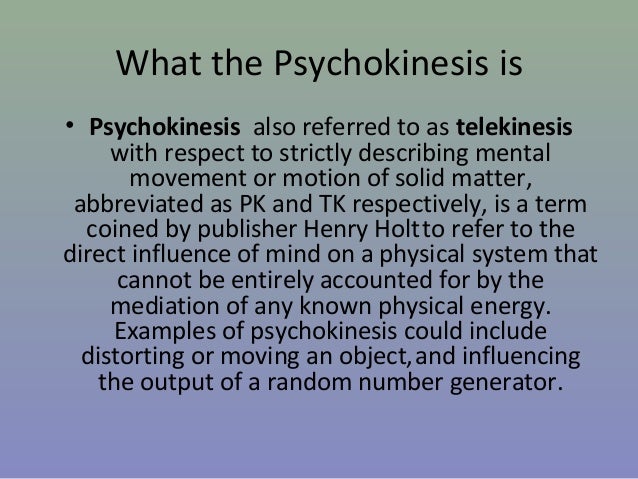Psychokinesis Moving Matter With The Mind Pdf
Read Online or Download Psycho-Kinesis: Moving Matter With the Mind PDF. Similar new age & spirituality books. A guide to telekinesis (Moving Objects using your mind), including how it works and how to develop it. Psychokinesis: Facts About Mind Over Matter. As the lightweight pieces would clearly be disturbed if the pages were moving because. Facts About Mind Over Matter.
Psychokinesis (PK), also known as Telekinesis (TK) or Mind over Matter, is the paranormal ability to move objects with mind power. It is the paranormal ability to move or bend objects with the power of the mind. This ability is also referred to as 'distant influencing' and 'remote mental influence'. People who possess this ability are said to be Telekinetic or Psychokinetic. Examples There are people who can manipulate temperatures. Some can move objects. Some can affect the magnetic fields.
Then there are some psychics who can only affect molecules around them. This particular effect is not visible to the naked eye. Experiments have been conducted on animals and plants - where mice have been wounded and plants have been watered. Most of this was considered to be hocus-pocus by people at large. It was only when scientific experiments by parapsychologists proved these abilities to be true, that people began to believe that such capabilities really existed. Theory The theory behind PK or TK, as it is popularly called, is that such people are able to manipulate the molecules of matter present within objects, so that they move or bend. The concept is that all of us are made of the same matter and therefore manipulating the energy molecules is simply a matter of communicating with them.

This ability is quite unique and astounding. Scientists have conducted several experiments with people claiming to have psychic abilities of such kind. These experiments have revealed a lot of information about PK. Parapsychologists also claim that almost all of us have the capability to get in touch with similar powers within us. There are several websites on the internet offering interesting exercises to help develop psychic abilities. Is Telekinesis Real? Well, just as there are people with real abilities, there are people who fake it.
Sleight of hand and manipulation of video cameras is quite a common phenomenon too. Yet, there are those among us who do possess these qualities and gifts.
These gifts are such that they are often hidden for fear of ridicule and criticism. These are also abilities which may or may not be duplicable. For example, someone who has bent a spoon now may not be able to do so again. That is not to say that he / she has lost his ability, but then sometimes, these gifts don't perform to demand. It helps to be smart before one believes the psychic capabilities of a person.
Better to see for real.
Moving Matter With The Mind
Uri Geller, shown speaking at a press event in Moscow in 2009, made millions in the 1970s by claiming he could bend spoons with his mind. Credit: / In the 1970s, Uri Geller became the world's best-known psychic and made millions traveling the world demonstrating his claimed psychokinetic abilities, including starting broken watches and bending spoons. Though he denied using magic tricks, many skeptical researchers observed that all of Geller's amazing feats could be — and have been — duplicated by magicians. Public interest in psychokinesis returned in the 1980s. One person nationally known for claimed psychokinetic ability, James Hydrick, tried to demonstrate his powers on the television show 'That's My Line' in 1981, following several successful television appearances.
He claimed to move small objects, such as a pencil or the pages of a telephone book, with his mind. Host Bob Barker consulted with skeptic James Randi, who suspected that Hydrick was merely discreetly blowing on the pages to make them move.
To prevent this method of trickery Randi placed styrofoam bits around the open book, as the lightweight pieces would clearly be disturbed if the pages were moving because of Hydrick's breath instead of his mind. After many awkward minutes in front of Barker, Randi, a panel of judges, and the live studio audience, a flustered Hydrick finally said that his powers weren't cooperating. Hydrick later admitted that his psychokinetic powers had been faked, and marveled at how easy it had been to fool the public.
Moving Matter With The Mind Book
Frauds and fakery The history of psychokinesisis a history of frauds and fakery, both proven and suspected. Even many researchers admit that the data fall far short of scientific standards of proof; researcher Russell Targ, in his book 'The Reality of ESP' (2012, Quest Books) acknowledges that 'the evidence for laboratory psychokinesis is quite weak.' Recent advances in virtual reality technology may, however, be the next best thing. In 2017, a company called Neurable announced plans to develop psychokinesis — or at least a virtual reality form of it — for a game called Awakening. Using a combination of eye movement tracking technology and electroencephalogram (EEG) sensors in a headset, the game allows a player to move and manipulate objects in a virtual world merely by looking and thinking. After an initial calibration process that takes several minutes, the players can select and move computer-generated images.
Perhaps one day technology will allow us to actually move objects with our thoughts, but until then we must be satisfied with the power depicted in fiction and fantasy. Benjamin Radford, Live Science Contributor Benjamin Radford is the Bad Science columnist for Live Science. He covers pseudoscience, psychology, urban legends and the science behind 'unexplained' or mysterious phenomenon.
Ben has a master's degree in education and a bachelor's degree in psychology. He is deputy editor of Skeptical Inquirer science magazine and has written, edited or contributed to more than 20 books, including ',' ' and “Investigating Ghosts: The Scientific Search for Spirits,” out in fall 2017. His website is www.BenjaminRadford.com.
Benjamin Radford, Live Science Contributor on.